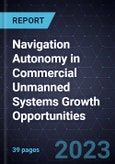Lowering Sensor Costs Drive Improvements in Autonomous Navigation Functions for Unmanned Platforms
Artificial intelligence (AI) advancements are helping companies automate unmanned solutions designed for commercial tasks. While the adoption rate varies based on the domain the unmanned system operates, all unmanned solutions benefit from this development.
To enable autonomous navigation features in unmanned systems, OEMs must equip their products with various sensors that allow the robotic platform to perceive its surroundings and make decisions accordingly. Of the potential sensors, LiDAR technology is expected to register the highest growth because it is the most reliable technology for autonomous navigation. However, the high costs associated with LiDAR technology and negative public perception regarding the use of unmanned systems in public spaces could delay widespread adoption and limit regulatory changes that encourage end users to adopt unmanned platforms with autonomous navigation features.
Despite these developments, rising labor costs and improvements in AI algorithms are anticipated to drive end users to slowly transition toward newer, autonomous unmanned platforms that can carry out commercial tasks more safely and efficiently. Autonomous navigation features in unmanned platforms may also simplify the integration of unmanned solutions into existing workflows by removing the need for an experienced pilot.
Table of Contents
1. Strategic Imperatives
- Why is it Increasingly Difficult to Grow?
- The Strategic Imperative 8™
- The Impact of the Top 3 Strategic Imperatives on Autonomous Navigation in Commercial Unmanned Systems
- Growth Opportunities Fuel the Growth Pipeline Engine™
2. Growth Opportunity Analysis
- Research Scope
- Overview, Trends, and Challenges
- Different Levels of Navigation Autonomy for Unmanned Systems
- Main Sensing Components Used for Autonomous Navigation in Unmanned Systems
- Types of LiDAR Sensors
- Forecast Global Market Size of Sensor Components for Unmanned Systems by Segment in 2027
- Impact of Autonomous Navigation on Commercial Segments - Unmanned Ground Systems
- Impact of Autonomous Navigation on Commercial Segments - Unmanned Aerial Systems
- Impact of Autonomous Navigation on Commercial Segments - Unmanned Maritime Systems
- Comparative Adoption Speed of Autonomous Navigation Features Across Unmanned System Segments
- Adoption of LiDAR Technology for UGV/UAS and Automobiles
- Representative Manufacturers of Sensing Components for Autonomous Navigation of Unmanned Systems
- Representative Manufacturers of Global Navigation Satellite System (GNCC) Chipsets for Localization of Unmanned Systems
- Key Companies Developing LiDAR Sensors for Unmanned Aerial Systems
- Key Companies Developing LiDAR Sensors for Unmanned Ground Vehicles
- Growth Drivers
- Growth Restraints
3. Commercial UAS Navigation - Autonomy
- Growth Opportunity 1: Autonomous Navigation for Unmanned Ground Vehicles for Last-mile Deliveries
- Growth Opportunity 2: LiDAR Sensors for Autonomous Navigation Features in Unmanned Platforms
- Growth Opportunity 3: Autonomous Navigation Features to Enable Widespread Automation of Infrastructure Inspections
4. Key Takeaways
- Key Conclusions
- List of Exhibits
- Legal Disclaimer








